1970s
Ethel Merman’s Disco Album
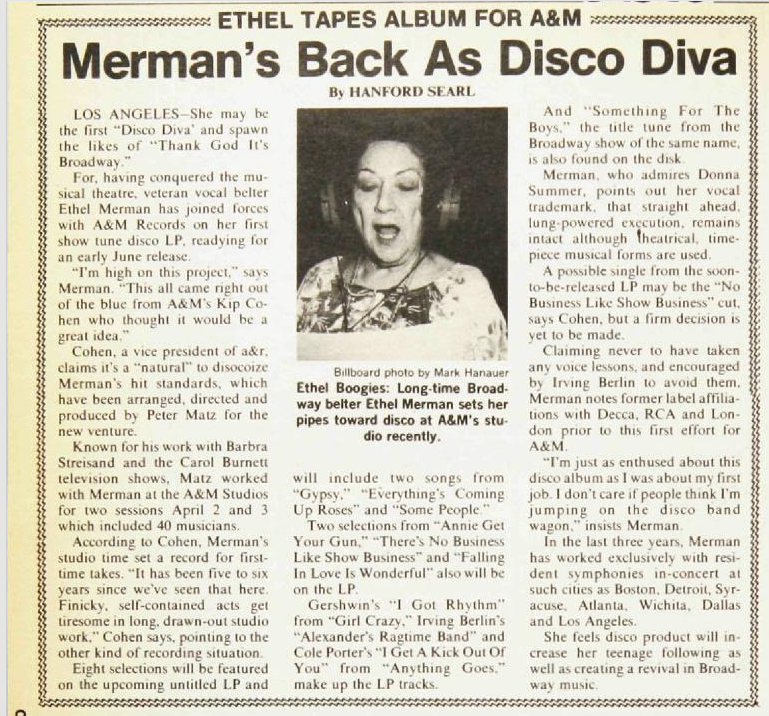
Source of story.
Posted By: Paul - Thu Aug 10, 2017 -
Comments (5)
Category: Excess, Overkill, Hyperbole and Too Much Is Not Enough, Music, 1970s, Cacophony, Dissonance, White Noise and Other Sonic Assaults
Sexy Pineapple Diet
This diet from 1970 was simple. Just eat only pineapple for two days every week. On the other days you can eat whatever you want. The book is apparently quite a rarity, because I haven't been able to find any used copies for sale.Over at vice.com, a guy recently tried the diet and claims that he lost 1 kilogram (2.2 lbs) in three days. Which, actually, isn't a lot. Evidently, he was able to find a copy of the book. He also discovered that one of its authors, Sten Hegeler, was still alive, 93 years old. When contacted, Hegeler admitted that not a lot of deep thought went into the concept of the diet:
And a bonus for linguaphiles: The word "erogetic" appears to have been invented for this book. I'm not sure what it means.


Fort Myers News-Press - Sep 16, 1970
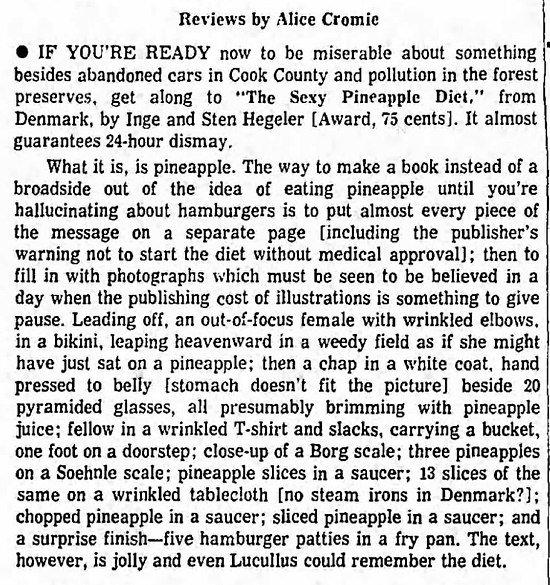
Chicago Tribune - Nov 5, 1970
Posted By: Alex - Wed Aug 09, 2017 -
Comments (6)
Category: Food, 1970s, Dieting and Weight Loss
The Beachcombers
The longest-running English-language show on Canadian TV looks just awful. How could it be otherwise, with this premise, as detailed in their Wikipedia entry.
The Beachcombers followed the life of Nick Adonidas (Bruno Gerussi), a Greek-Canadian log salvager in British Columbia who earned a living travelling the coastline northwest of Vancouver with his partner Jesse Jim (Pat John) aboard their logging tug Persephone tracking down logs that had broken away from barges and logging booms. Their chief business competitor is Relic (Robert Clothier) (whose actual name is Stafford T. Phillips), a somewhat unsavoury person who will occasionally go to great lengths to steal business (and logs) away from Nick. The series also focused on a supporting cast of characters in Nick's hometown of Gibsons, often centering on a café, Molly's Reach, run by Molly (Rae Brown), a mother figure to virtually all the characters in the series (including Relic). Molly had two grandchildren living with her, Hughie (Bob Park) and his younger sister Margaret played by Nancy Chapple in the first season then by Juliet Randall from the second season onward.
There are some full episodes on YouTube if anyone is brave enough to watch. Maybe a Canadian WU-vie will fill us in!
Posted By: Paul - Sun Aug 06, 2017 -
Comments (6)
Category: Ineptness, Crudity, Talentlessness, Kitsch, and Bad Art, Nature, Natural Resources, 1970s
The Films of Suzan Pitt
Wikipedia page.
Posted By: Paul - Sun Jul 30, 2017 -
Comments (6)
Category: Art, Avant Garde, Cartoons, 1970s
The Orgatron, or, Tote-a-Tune
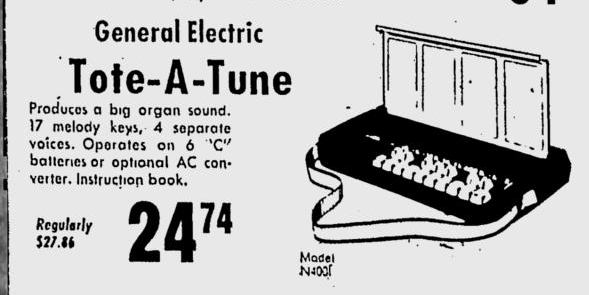
Ad source.
Another pre-digital electronic keyboard.
Some background here.
And here.
Posted By: Paul - Fri Jul 28, 2017 -
Comments (4)
Category: Music, Technology, 1930s, 1970s
The Maid of Cotton Pageant
Continuing our intermittent look at oddball beauty pageants.The Maid of Cotton pageant began in 1939. The annual pageant was sponsored by the National Cotton Council (NCC), Memphis Cotton Carnival, and the Cotton Exchanges of Memphis, New York, and New Orleans. The pageant was held in Memphis, Tennessee, in conjunction with the Carnival until the 1980s.
In mid-December every year the NCC released a list of contestants. Contestants were required to have been born in one of the cotton-producing states: Alabama, Arizona, Arkansas, California, Florida, Georgia, Kentucky, Louisiana, Mississippi, Missouri, New Mexico, North and South Carolina, Oklahoma, Tennessee, Texas or Virginia. They might have also been born in the cotton-producing counties of Alexander, Jefferson, Massac, Pulaski, Williamson or Madison, Illinois or in Clark or Nye counties of Nevada. There were usually twenty contestants each year.
Contestants were judged on personality, good manners, intelligence, and family background as well as beauty and an ability to model. A Top Ten were chosen and then a Top Five, and finally second and first runners up and a winner. Winners served as goodwill and fashion ambassadors of the cotton industry in a five-month, all-expense tour of American cities. In the mid-1950s the tour expanded globally. In the late 1950s a Little Miss Cotton pageant was begun but lasted only until 1963 before being discontinued. In the mid-1980s Dallas,Texas took over the pageant, in conjunction with the NCC and its overseas division, Cotton Council International. In 1986, to bolster interest and participation, the NCC eliminated the rule requiring contestants to be born in a cotton-producing state. The pageant was discontinued in 1993, one of the reasons being that Cotton Inc. stopped contributing scholarship money as well as waning public interest and changing marketing strategies.
More details here.
And also here.
The 1952 winner.

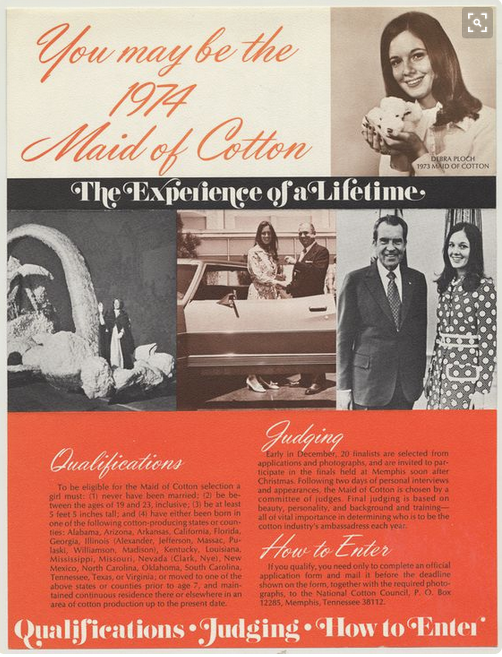
Posted By: Paul - Fri Jul 21, 2017 -
Comments (3)
Category: Beauty, Ugliness and Other Aesthetic Issues, Contests, Races and Other Competitions, 1930s, 1940s, 1950s, 1960s, 1970s, 1980s, 1990s
Mystery Illustration 51
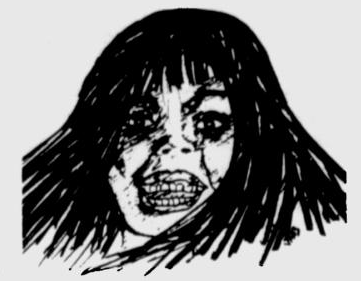
Which internationally famous best-selling singer of the 1970s is this supposed to be?
Answer is here.
And after the jump.
More in extended >>
Posted By: Paul - Thu Jul 20, 2017 -
Comments (3)
Category: Ineptness, Crudity, Talentlessness, Kitsch, and Bad Art, 1970s
L.A. Knockers
The L.A. Knockers was an all-female dance troupe that formed in 1974 and stayed together (with members coming and going) for 12 years.There's a fan page here. And one of the original members has posted a collection of L.A. Knockers videos on YouTube.

It was their name and ultra 70s look that first caught my attention. But when I googled about them, I discovered they also had a run-in with tragedy. One of the original members, Lissa Kastin (middle, above), became a victim of the Hillside Strangler in 1977.
Posted By: Alex - Wed Jul 19, 2017 -
Comments (2)
Category: 1970s, Dance
Man-Pleasing Recipes
The title of this 1971 recipe book was somewhat misleading. It claimed to feature "Man-Pleasing Recipes," but really it was a collection of recipes featuring rice as the main ingredient. The booklet was put out by the Rice Council for P.R. purposes. Part of an effort to promote rice as a manly food.Can't say it succeeded. When I think of foods traditionally perceived as "manly," rice isn't one of the things that comes to mind.

source: Amazon.com

The Liberty Vindicator - Sep 7, 1972

One of the "man-pleasing recipes"
Shreveport Times - Oct 14, 1971
Posted By: Alex - Mon Jul 17, 2017 -
Comments (3)
Category: Food, Cookbooks, Books, 1970s
Hear Muffs
Straight out of the 70s. Hear Muffs were the invention of Stephen Hanson of Downers Grove, Illinois. They were headphones encased in a wraparound foam pillow, that came with a washable velour cover.Hanson started selling them in 1972, but by around 1977 the product seems to have been discontinued. Perhaps because you'd only want to wear them in bed. And even then, it was probably difficult to lie on your side while wearing them.
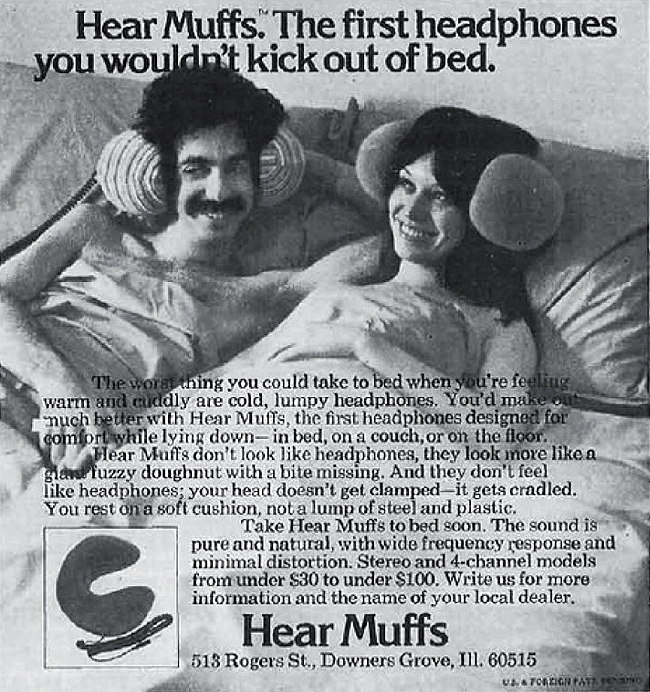


Honolulu Star Bulletin - Aug 16, 1974
Posted By: Alex - Thu Jul 06, 2017 -
Comments (3)
Category: Inventions, 1970s

| Who We Are |
|---|
| Alex Boese Alex is the creator and curator of the Museum of Hoaxes. He's also the author of various weird, non-fiction, science-themed books such as Elephants on Acid and Psychedelic Apes. Paul Di Filippo Paul has been paid to put weird ideas into fictional form for over thirty years, in his career as a noted science fiction writer. He has recently begun blogging on many curious topics with three fellow writers at The Inferior 4+1. Contact Us |




